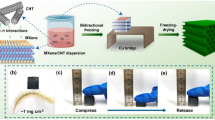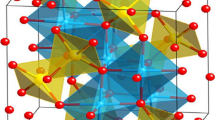Abstract
To obtain the highest performance of supercapacitive properties, it is necessary to discover an appropriate pair of electrode material and electrolyte. Supercapacitors have many applications in the industry over batteries, and our result shows the advantages of low-cost polyaniline (PANI) electrode material in supercapacitors. In the present work, the polyaniline nanofibers (PANINFs) thin films can be directly used as an electrode for supercapacitor. PANINFs electrode showed maximum specific capacitance of 633 F/g which exhibited at 5 mV/s scan rate, the specific energy density of 45.67 Wh/kg, the power density of 500 W/kg and the coulomb efficiency of 85.59% at 0.5 mA/cm2 current density with 0.32 Ω equivalent series resistance (ESR) value. The capacitance value is obtained by electrochemical impedance spectroscopy (EIS) of 20.33 mF/cm2 with the relaxation time of 0.14 s. Nanofibrous network (50–60 nm diameter) confirmed hydrophilic nature by wettability test. From the supercapacitive performance of PANINFs thin films conclude that they are promising for energy storage application.
Graphical abstract








Similar content being viewed by others
References
Chen Y, Zhang X, Zhang D et al (2011) High performance supercapacitors based on reduced graphene oxide in aqueous and ionic liquid electrolytes. Carbon N Y 49:573–580. https://doi.org/10.1016/j.carbon.2010.09.060
Wang F, Sun S, Xu Y et al (2017) High performance asymmetric supercapacitor based on Cobalt Nickle Iron-layered double hydroxide/carbon nanofibres and activated carbon. Sci Rep 7:1–11. https://doi.org/10.1038/s41598-017-04807-1
Anwar AW, Majeed A, Iqbal N et al (2015) Specific capacitance and cyclic stability of graphene based metal/metal oxide nanocomposites: a review. J Mater Sci Technol 31:699–707. https://doi.org/10.1016/j.jmst.2014.12.012
Ghouri ZK, Shaheer Akhtar M, Zahoor A et al (2015) High-efficiency super capacitors based on hetero-structured α-MnO2 nanorods. J Alloys Compd 642:210–215. https://doi.org/10.1016/j.jallcom.2015.04.082
Wang G, Zhang L, Zhang J (2012) A review of electrode materials for electrochemical supercapacitors. Chem Soc Rev 41:797–828. https://doi.org/10.1039/C1CS15060J
Gupta V, Miura N (2006) Influence of the microstructure on the supercapacitive behavior of polyaniline/single-wall carbon nanotube composites. J Power Sources 157:616–620. https://doi.org/10.1016/j.jpowsour.2005.07.046
Giuliani E, Demetrio RFÆ, Soares AW (2008) Electrical properties of electrodeposited polyaniline nanotubes. J Mater Sci Mater Electron 19:457–462. https://doi.org/10.1007/s10854-007-9362-x
Dhawale DS, Dubal DP, Jamadade VS et al (2010) Fuzzy nanofibrous network of polyaniline electrode for supercapacitor application. Synth Met 160:519–522. https://doi.org/10.1016/j.synthmet.2010.01.021
Chao Y, Chen S, Chen H et al (2018) Densely packed porous graphene film for high volumetric performance supercapacitor. Electrochim Acta 276:118–124. https://doi.org/10.1016/j.electacta.2018.04.156
Zhang J, Ji X, Zhou J et al (2018) Pyridinium substituted BODIPY as NIR fluorescent probe for simultaneous sensing of hydrogen sulphide/glutathione and cysteine/homocysteine. Sens Actuators B Chem 257:1076–1082. https://doi.org/10.1016/j.snb.2017.10.133
Ghouri ZK, Barakat NAM, Kim HY (2015) Influence of copper content on the electrocatalytic activity toward methanol oxidation of Co ‡ Cu y alloy nanoparticles-decorated CNFs. Sci Rep 5:1–12. https://doi.org/10.1063/1.109598
Ghouri ZK, Barakat NAM, Park M et al (2015) Synthesis and characterization of Co/SrCO3 nanorods-decorated carbon nanofibers as novel electrocatalyst for methanol oxidation in alkaline medium. Ceram Int 41:6575–6582. https://doi.org/10.1016/j.ceramint.2015.01.103
Barakat NAM, El-Newehy M, Al-Deyab SS, Kim HY (2014) Cobalt/copper-decorated carbon nanofibers as novel non-precious electrocatalyst for methanol electrooxidation. Nanoscale Res Lett 9:1–10. https://doi.org/10.1186/1556-276X-9-2
Khan Z, Khaled G, Saeed E, Barakat ANAM (2017) Applicable anode based on Co3O4–SrCO3 heterostructure nanorods-incorporated CNFs with low-onset potential for DUFCs. Appl Nanosci 7:625–631. https://doi.org/10.1007/s13204-017-0601-z
Al-Meer S, Ghouri ZK, Elsaid K et al (2017) Engineering of magnetically separable ZnFe2O4@ TiO2 nanofibers for dye-sensitized solar cells and removal of pollutant from water. J Alloys Compd 723:477–483. https://doi.org/10.1016/j.jallcom.2017.06.211
Ghouri ZK, Barakat NAM, Kim HY et al (2016) Nano-engineered ZnO/CeO2dots@CNFs for fuel cell application. Arab J Chem 9:219–228. https://doi.org/10.1016/j.arabjc.2015.05.024
Ali Y, Kumar V, Sonkawade RG et al (2013) Two-step electrochemical synthesis of Au nanoparticles decorated polyaniline nanofiber. Vacuum 93:79–83. https://doi.org/10.1016/j.vacuum.2013.01.007
Zhang H, Wang J, Wang Z et al (2009) Electrodeposition of polyaniline nanostructures: a lamellar structure. Synth Met 159:277–281
Prasad KR, Munichandraiah N (2002) Potentiodynamically deposited polyaniline on stainless steel. J Electrochem Soc 149:A1393. https://doi.org/10.1149/1.1509458
Zhou KL, Wang H, Jiu JT et al (2018) Polyaniline films with modified nanostructure for bifunctional flexible multicolor electrochromic and supercapacitor applications. Chem Eng J 345:290–299. https://doi.org/10.1016/j.cej.2018.03.175
Yuan Y, Zhu W, Du G et al (2018) Two-step method for synthesizing polyaniline with bimodal nanostructures for high performance supercapacitors. Electrochim Acta. https://doi.org/10.1016/j.electacta.2018.06.006
Ghouri ZK, Barakat NAM, Saud PS et al (2016) Supercapacitors based on ternary nanocomposite of TiO2&Pt@graphenes. J Mater Sci Mater Electron 27:3894–3900. https://doi.org/10.1007/s10854-015-4239-x
Ghouri ZK, Barakat NAM, Kim HY (2015) Synthesis and electrochemical properties of MnO2 and co-decorated graphene as novel nanocomposite for electrochemical super capacitors application. Energy Environ Focus 4:34–39. https://doi.org/10.1166/eef.2015.1136
Ghouri ZK, Barakat NAM, Alam AM et al (2015) Synthesis and characterization of Nitrogen-doped & CaCO3-decorated reduced graphene oxide nanocomposite for electrochemical supercapacitors. Electrochim Acta 184:193–202. https://doi.org/10.1016/j.electacta.2015.10.069
Zhang X, Meng X, Wang Q et al (2018) Preparation and electrochemical investigation of polyaniline nanowires for high performance supercapacitor. Mater Lett 217:312–315. https://doi.org/10.1016/j.matlet.2018.01.112
Deshmukh PR, Shinde NM, Patil SV et al (2013) Supercapacitive behavior of polyaniline thin films deposited on fluorine doped tin oxide (FTO) substrates by microwave-assisted chemical route. Chem Eng J 223:572–577. https://doi.org/10.1016/j.cej.2013.03.056
Ghouri ZK, Barakat NAM, Alam A-M et al (2015) Facile synthesis of Fe/CeO2-doped CNFs and their capacitance behavior. Int J Electrochem Sci 10:2064–2071
Sumboja A, Wang X, Yan J, Lee PS (2012) Nanoarchitectured current collector for high rate capability of polyaniline based supercapacitor electrode. Electrochim Acta 65:190–195. https://doi.org/10.1016/j.electacta.2012.01.046
Dhawale DS, Salunkhe RR, Jamadade VS et al (2010) Hydrophilic polyaniline nanofibrous architecture using electrosynthesis method for supercapacitor application. Curr Appl Phys 10:904–909. https://doi.org/10.1016/j.cap.2009.10.020
Li N, Xiao Y, Xu C et al (2013) Facile preparation of polyaniline nanoparticles via electrodeposition for supercapacitors. Int J Electrochem Sci 8:1181–1188
Sazou D, Kourouzidou M, Pavlidou E (2007) Potentiodynamic and potentiostatic deposition of polyaniline on stainless steel: electrochemical and structural studies for a potential application to corrosion control. Electrochim Acta 52:4385–4397. https://doi.org/10.1016/j.electacta.2006.12.020
Saini P, Choudhary V, Singh BP et al (2009) Polyaniline—MWCNT nanocomposites for microwave absorption and EMI shielding. Mater Chem Phys 113:919–926. https://doi.org/10.1016/j.matchemphys.2008.08.065
Gupta V, Miura N (2005) Large-area network of polyaniline nanowires prepared by potentiostatic deposition process. Electrochem Commun 7:995–999. https://doi.org/10.1016/j.elecom.2005.07.008
Jamadade VS, Dhawale DS, Lokhande CD (2010) Studies on electrosynthesized leucoemeraldine, emeraldine and pernigraniline forms of polyaniline films and their supercapacitive behavior. Synth Met 160:955–960. https://doi.org/10.1016/j.synthmet.2010.02.007
Sowmya SY, Selvakumar M (2016) Supercapacitor studies of electrochemically synthesized multi-layered polyaniline on stainless steel substrate. Ionics (Kiel) 22:1729–1739. https://doi.org/10.1007/s11581-016-1705-2
Buron CC, Lakard B, Monnin AF et al (2011) Elaboration and characterization of polyaniline films electrodeposited on tin oxides. Synth Met 161:2162–2169. https://doi.org/10.1016/j.synthmet.2011.08.021
Li GR, Feng ZP, Zhong JH et al (2010) Electrochemical synthesis of polyaniline nanobelts with predominant electrochemical performances. Macromolecules 43:2178–2183. https://doi.org/10.1021/ma902317k
Shinde PA, Lokhande VC, Chodankar NR et al (2016) Enhanced electrochemical performance of monoclinic WO3 thin film with redox additive aqueous electrolyte. J Colloid Interface Sci 483:261–267. https://doi.org/10.1016/j.jcis.2016.08.011
Deshmukh PR, Pusawale SN, Jamadade VS et al (2011) Microwave assisted chemical bath deposited polyaniline films for supercapacitor application. J Alloys Compd 509:5064–5069. https://doi.org/10.1016/j.jallcom.2010.12.009
Dhawale DS, Vinu A, Lokhande CD (2011) Stable nanostructured polyaniline electrode for supercapacitor application. Electrochim Acta 56:9482–9487. https://doi.org/10.1016/j.electacta.2011.08.042
Li T, Zhou Y, Liang B et al (2017) One–pot synthesis and electrochemical properties of polyaniline nanofibers through simply tuning acid–base environment of reaction medium. Electrochim Acta 249:33–42. https://doi.org/10.1016/j.electacta.2017.07.177
Dubal DP, Fulari VJ, Lokhande CD (2012) Effect of morphology on supercapacitive properties of chemically grown β-Ni(OH)2 thin films. Microporous Mesoporous Mater 151:511–516. https://doi.org/10.1016/j.micromeso.2011.08.034
Dubal DP, Gund GS, Holze R et al (2013) Surfactant-assisted morphological tuning of hierarchical CuO thin films for electrochemical supercapacitors. Dalton Trans 42:6459. https://doi.org/10.1039/c3dt50275a
Jagadale AD, Dubal DP, Lokhande CD (2012) Electrochemical behavior of potentiodynamically deposited cobalt oxyhydroxide (CoOOH) thin films for supercapacitor application. Mater Res Bull 47:672–676. https://doi.org/10.1016/j.materresbull.2011.12.029
Mujawar SH, Ambade SB, Battumur T et al (2011) Electropolymerization of polyaniline on titanium oxide nanotubes for supercapacitor application. Electrochim Acta 56:4462–4466. https://doi.org/10.1016/j.electacta.2011.02.043
Chen W, Rakhi RB, Alshareef HN (2013) Facile synthesis of polyaniline nanotubes using reactive oxide templates for high energy density pseudocapacitors. J Mater Chem A 1:3315–3324. https://doi.org/10.1039/c3ta00499f
Kuang H, Cao Q, Wang X et al (2013) Influence of the reaction temperature on polyaniline morphology and evaluation of their performance as supercapacitor electrode. J Appl Polym Sci 130:3753–3758. https://doi.org/10.1002/app.39650
Chen YC, Hsu YK, Lin YG et al (2011) Highly flexible supercapacitors with manganese oxide nanosheet/carbon cloth electrode. Electrochim Acta 56:7124–7130. https://doi.org/10.1016/j.electacta.2011.05.090
Shinde PA, Lokhande AC, Chodankar NR et al (2017) Temperature dependent surface morphological modifications of hexagonal WO3 thin films for high performance supercapacitor application. Electrochim Acta 224:397–404. https://doi.org/10.1016/j.electacta.2016.12.066
Li T, Qin Z, Liang B et al (2015) Morphology-dependent capacitive properties of three nanostructured polyanilines through interfacial polymerization in various acidic media. Electrochim Acta 177:343–351. https://doi.org/10.1016/j.electacta.2015.03.169
Acknowledgements
Authors are thankful to PIFC center, Department of Physics, Shivaji University, Kolhapur for providing XRD, Contact angle, FESEM and electrochemical measurements.
Author information
Authors and Affiliations
Corresponding author
Rights and permissions
About this article
Cite this article
Waikar, M.R., Shaikh, A.A. & Sonkawade, R.G. PANINFs synthesized electrochemically as an electrode material for energy storage application. Polym. Bull. 76, 4703–4718 (2019). https://doi.org/10.1007/s00289-018-2634-1
Received:
Revised:
Accepted:
Published:
Issue Date:
DOI: https://doi.org/10.1007/s00289-018-2634-1




